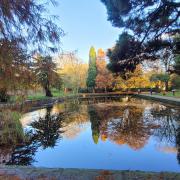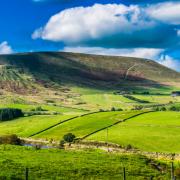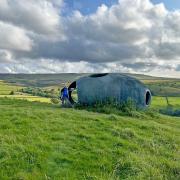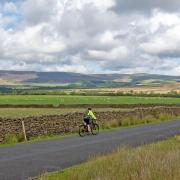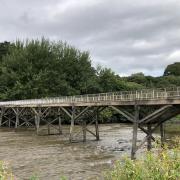It’s second time lucky for Keith Carter as he finds a walk from Melling in the Lune Valley

The Lune Valley has many things to recommend it but one drawback: there are few crossing places, none between Kirkby Lonsdale and Hornby so day walks must be confined to one side of the river or the other. The river follows a roughly north/south direction and the east side offers the best prospects for walkers, the west side offering limited prospects due to a lack of public footpaths.
In researching this month’s walk it took two attempts to devise a walk of the right length and accessibility. If you scan this column regularly you will be aware that I walk every route, sometimes more than once, having first plotted where I want to go using my computer software. OS maps are available on screen now with lots of additional information, height gained, distance covered, time taken and so on, for downloading onto a GPS or mobile phone if that’s your preference. Personally I prefer a hard copy of a map but that may be because that is what I am accustomed to. You do see walkers using GPS but not very often. Truth to tell I seldom come across other walkers on my routes. Perhaps they are all on the Lakeland Fells, bagging Wainwrights.
My first attempt to create a walkable route from Melling intended going downstream to Loyn Bridge, diverting to Hornby for a pint at the Royal Oak, then returning via Castle Stede, crossing the A683 and heading up over Cockshotts to return to Melling but the first obstacle was a field full of cows by the river. These days ramblers are more wary of cows following several news stories of attacks on walkers in fields and this puts people off. It’s safe enough to enter a field full of heifers but if they have calves with them it’s worth finding an alternative route.
Another problem arose when my companion Jim pulled a hamstring and was forced to make his way back to Melling by bus. This in itself went pear-shaped when two buses came along at once. The first one stopped for Jim waiting at the bus stop in Hornby while the second pulled out, overtook and sped away. The trouble was the one that stopped was the Bentham bus which did not go via Melling and the Melling bus was the one that sped away. Thanks to the kindness of strangers Jim got to Melling safely. I wouldn’t like to be on the receiving end of the letter he threatened to send to the bus operator.

My second visit to Melling resulted in this month’s walk and is an improvement on the first. It takes about two and a half hours and involves no cows, no buses and no unexpected hazards, so here it is.
Take the Kirkby Lonsdale road from Hornby and as you come out of Melling just past CA Stephenson’s motorcycle garage there is a turning on the left where a couple of cars can be safely left. If you find yourself going under the railway bridge, you have gone too far. Walk down the lane between hedges and pass the entrance to a property called Dunromin on the right. Shortly afterwards turn right, go under the railway and at the next fork keep right.
We enter a narrow, rutted green lane which is quite hard to walk on due to its uneven surface added to which a trail bike had recently been along and churned up a muddy wheel rut. Keep going to the end where at a gate one path goes right, the other, ours, goes through the gate and continues forward along a right hand boundary consisting of a thick hedge, a fence and a single line of barbed wire, quite an effective barrier. I doubt even an elephant could get through it.
Gradually leave the boundary and take a line via scattered group of trees and look for a stile in the crossing fence, or rather a double stile which brings us onto a raised bank above the level of the large field on our right. We find ourselves alongside the River Greta, flowing into the Lune, the bank heading upstream all the way to Greta Bridge over the A683. The Greta flows down from Ingleton formed by two smaller rivers, the Twiss and the Doe, joining there. I can think of two other Gretas, the one that flows through Keswick and the other in County Durham, a tributary of the Tees. The name comes from the Norse, a stony stream.

At Greta Bridge a flight of stone steps leads up to the road. Cross the road, not the bridge, and on the opposite side at an opening, a footpath sign points diagonally across a field. This was densely sown with maize at the time of our visit with no path left for the footpath so we went round the edge to the left, along the edge of the crop with the river to our left, leaving the field at a stile and emerging at the village of Wrayton, silent and tranquil in the sunshine without so much as a strimmer to disturb the peace.
Our way turns left and leaves the village, the lane going gradually uphill then dipping to pass the large farmstead called Bull Bank. Beyond it the lane rises again and at the top there is an opening on the right where a stony track is our way forward. This is a bridleway that leads back to Melling, an ancient route that must have been a drovers’ road in times past. Perfect for walking, this is exactly what is meant by the term ‘green lane’.
As we get near to Melling the surface becomes metalled and we come to a junction with Lodge Lane close to a very tidy property called Galley Hill Farm. Turn right and walk downhill to the village. In the gateway to a house two small boys had set up their stall selling plasticine animals. Nice to see private enterprise at work. We asked what they intended doing with the money they hoped to raise.
‘Give it to our Dad,’ they replied, ‘for his business.’ The recession must be biting harder than I thought.
Turn right in the village and the car is parked a few paces down on the left. The rain had held off. There’s nowhere to get a brew in Melling so we drove to the Lunesdale Arms in Tunstall where they do a nice lunch. We had enjoyed the walk and it’s not every day you come home with two plasticine animals.
Compass points
Area of walk: Melling, Lune Valley
Distance: Four miles
Time to allow: 2½ hours
Map: OS Explorer OL2 Yorkshire Dales S and W
No refreshments on the walk. Try the Lunesdale Arms at Tunstall.
Not suitable for wheelchairs or pushchairs.
















